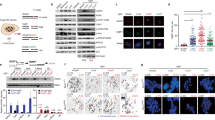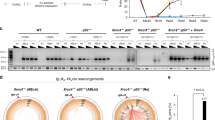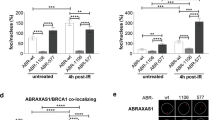Abstract
BS is an inherited cancer predisposition disorder caused by inactivation of the RecQ family helicase, BLM. One of the defining features of cells from BS individuals is chromosomal instability, characterized by elevated sister chromatid exchanges (SCEs), as well as chromosomal breaks, deletions, and rearrangements. Although the basis for chromosomal instability is poorly understood, there is evidence that chromosomal abnormalities can arise through an alteration in the efficiency or fidelity of DNA double strand break (DSB) repair. Here, we show that BS cells demonstrate aberrant DSB repair mediated by the non-homologous end-joining (NHEJ) pathway for DNA repair, one of the two main pathways for the repair of DSBs in mammalian cells. Through a comparison of BS cell lines, and a derivative in which the BS phenotype has been reverted by expression of the BLM cDNA, we show that BS cells display aberrant end-joining of DSBs. Importantly, DNA end-joining in BS cells is highly error-prone and frequently results in DNA ligation at distant sites of microhomology, creating large DNA deletions. This aberrant repair is dependent upon the presence of the Ku70/86 heterodimer, a key component in the NHEJ pathway. We propose that aberrant NHEJ is a candidate mechanism for the generation of chromosomal instability in BS.
This is a preview of subscription content, access via your institution
Access options
Subscribe to this journal
Receive 50 print issues and online access
$259.00 per year
only $5.18 per issue
Buy this article
- Purchase on Springer Link
- Instant access to full article PDF
Prices may be subject to local taxes which are calculated during checkout





Similar content being viewed by others
References
Baumann P, West SC . 1998 Proc. Natl. Acad. Sci. USA 95: 14066–14070
Bischoff O, Kim SH, Irving J, Beresten S, Ellis NA, Campisi J . 2001 J. Cell. Biol. 153: 367–380
Bradford MM . 1976 Anal. Biochem. 72: 248–254
Chakraverty RK, Hickson ID . 1999 Bioessays 21: 286–294
Difilipiantonio MJ, Zhu J, Chen HT, Meffre E, Nussenzweig MC, Max EE, Ried T, Nussenzweig A . 2000 Nature 400: 510–513
Ellis NA, Groden J, Ye TZ, Straughen J, Lennon DJ, Ciocci S, Proytcheva M, German J . 1995a Cell 83: 655–666
Ellis NA, Lennon DJ, Proytcheva M, Alhadeff B, Henderson EE, German J . 1995b Am. J. Hum. Genet. 57: 1019–1027
Ellis NA, German J . 1996 Hum. Mol. Genet. 5: 1457–1463
Feldmann E, Schmiemann V, Goedecke W, Reichenberger S, Pfeiffer P . 2000 Nuc. Acid Res. 28: 2585–2596
Garcia-Higuera I, Taniguchi T, Ganesan S, Meyn MS, Timmers C, Hejna J, Grompe M, D'Andrea AD . 2001 Mol. Cell. 7: 249–262
German J, Crippa LP, Bloom D . 1974 Chromosoma 48: 361–366
Hanada K, Ukita T, Kohno Y, Saito K, Kato J, Ikeda H . 1997 Proc. Natl. Acad. Sci. USA 94: 3860–3865
Jessberger R, Berg P . 1991 Mol. Cell. Biol. 1: 445–457
Karow JK, Chakraverty RK, Hickson ID . 1997 J. Biol. Chem. 272: 30611–30614
Karow JK, Wu L, Hickson ID . 2000 Curr. Opin. Genet. Dev. 10: 32–38
Khanna KK, Jackson SP . 2001 Nat. Genet. 27: 247–254
Kusano K, Johnson-Schlitz DM, Engels WR . 2001 Science 291: 2600–2602
Laemmli UK . 1970 Nature 227: 680–685
Langlois RG, Bigbee WL, Jensen RH, German J . 1989 Proc. Natl. Acad. Sci. USA 86: 670–674
Li L, Eng C, Desnick RJ, German J, Ellis NA . 1983 Mol. Genet. Metab. 64: 286–290
Li S, Ting NSY, Zheng L, Chen P-L, Ziv Y, Shiloh Y . 2000 Nature 406: 210–215
Moynahan ME, Pierce AJ, Jasin M . 2001 Mol. Cell. 7: 263–267
North P, Ganesh A, Thacker J . 1990 Nuc. Acids Res. 18: 6205–6210
Pastink A, Eeken JC, Lohman PH . 2001 Mutat. Res. 480–481: 37–50
Ray JH, German J . 1983 ed. Liss, New York, NY pp 135–167
Richardson C, Jasin M . 2000 Nature 405: 697–700
Roth DB, Porter TN, Wilson JH . 1985 Mol. Cell. Biol. 5: 2599–2607
Roth DB, Wilson JH . 1986 Mol. Cell. Biol. 6: 4295–4304
Runger TM, Kraemer KH . 1989 EMBO J. 8: 1419–1425
Tsukamoto Y, Kato J, Ikeda H . 1997 Nature 388: 900–903
Welcsh PL, King MC . 2001 Hum. Mol. Genet. 7: 705–713
Wu L, Davies SL, Levitt NC, Hickson ID . 2001 J. Biol. Chem. 276: 19375–19381
Yamagata K, Kato J, Shimamoto A, Goto M, Furuichi Y, Ikeda H . 1998 Proc. Natl. Acad. Sci. USA 95: 8733–8738
Acknowledgements
TJ Gaymes and FV Rassool are supported by the Elimination of Leukaemia Fund. PS North and ID Hickson are supported by the Imperial Cancer Research Fund.
Author information
Authors and Affiliations
Corresponding author
Rights and permissions
About this article
Cite this article
Gaymes, T., North, P., Brady, N. et al. Increased error-prone non homologous DNA end-joining – a proposed mechanism of chromosomal instability in Bloom's syndrome. Oncogene 21, 2525–2533 (2002). https://doi.org/10.1038/sj.onc.1205331
Received:
Revised:
Accepted:
Published:
Issue Date:
DOI: https://doi.org/10.1038/sj.onc.1205331
Keywords
This article is cited by
-
PRMT5 promotes DNA repair through methylation of 53BP1 and is regulated by Src-mediated phosphorylation
Communications Biology (2020)
-
MRN complex-dependent recruitment of ubiquitylated BLM helicase to DSBs negatively regulates DNA repair pathways
Nature Communications (2018)
-
Reconstitution of anaphase DNA bridge recognition and disjunction
Nature Structural & Molecular Biology (2018)
-
Synthetic lethal targeting of oncogenic transcription factors in acute leukemia by PARP inhibitors
Nature Medicine (2015)
-
DNA damage accumulation and repair defects in acute myeloid leukemia: implications for pathogenesis, disease progression, and chemotherapy resistance
Chromosoma (2014)



